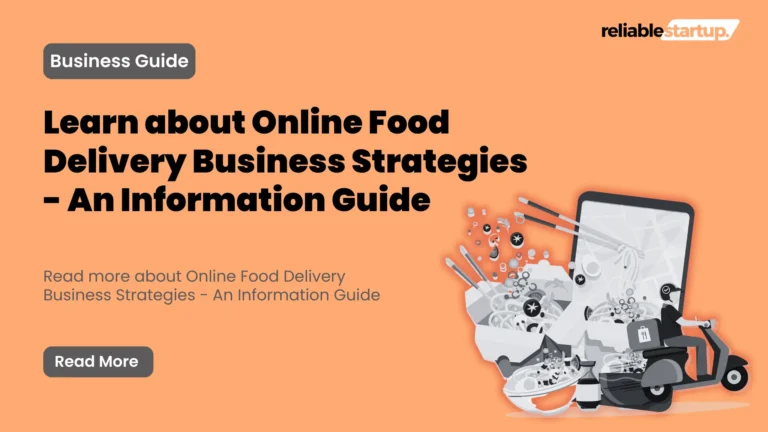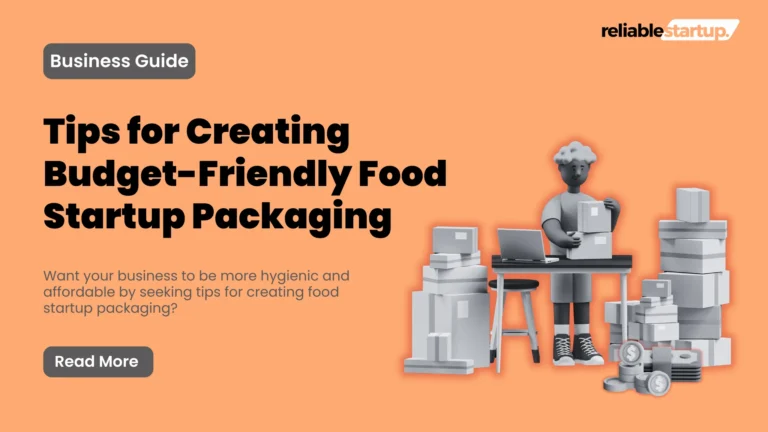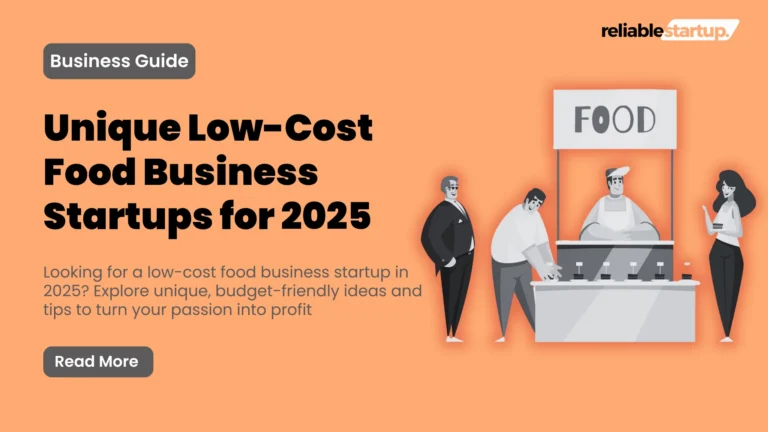7 Actionable Steps for Scaling a Local Food Business
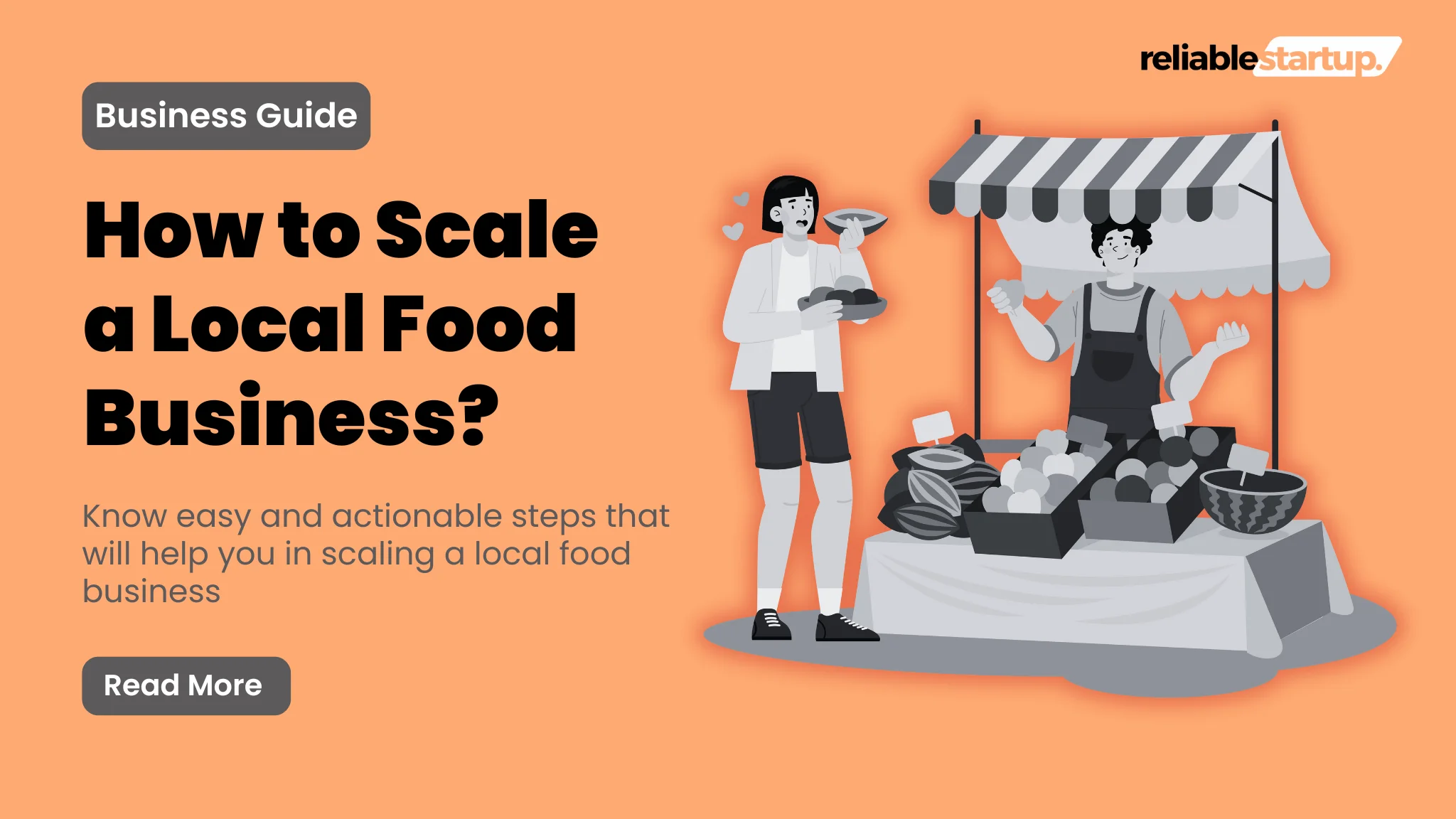
According to the Federal Reserve Bank of St. Louis, local food has become a mainstream consumer preference. This shows scaling in your local area is not that hard but it becomes hard and even difficult without proper planning and strategy.
This guide is for you. If you have a local business but don’t know how to scale it, then you must read this till the end. You will learn how to scale your local food business step by step. This guide shows you how to:
- Get ready to grow.
- Make a plan for success.
- Reach more customers.
- Keep your food tasty and your customers happy.
Let’s get started on making your dream food business bigger and better!
What is Scaling in the Food Business?
Scaling in the food business means growing your operations to serve more customers and make more money. If we simply put it, then it means increasing production, reaching new markets, and improving your systems to handle more demand.
But you have to do this while keeping the quality of your food and service top-notch.
If we further explain it, it means stretching your business without breaking it. You can scale your business by expanding your team, buying better tools and equipment, or using new ways of selling and marketing. But it takes time and efforts. You should not rush at it.
In addition, Scaling in other words also means thinking ahead. By thinking ahead we mean, when you plan in advance for more customers, more sales, higher costs, and upcoming challenges, we say this company is scaling.
However, below we have gathered 7 easy and actionable steps in the form of a guide that will help you in scaling a local food business.
7 Actionable Steps for Scaling a Local Food Business
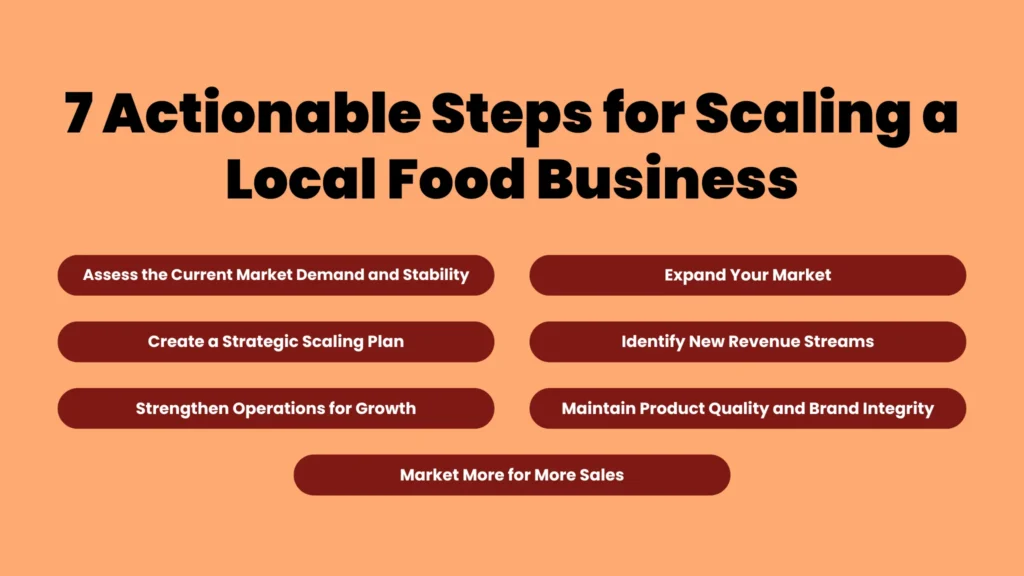
Assess the Current Market Demand and Stability
If you don’t know about the current market condition , you will never scale any business. So it is mandatory to do the current market analysis in your locale.
So to do this you need to ask yourself: Are you making enough money to cover your costs? Check if your profits are growing and if your team works smoothly. This will help you to understand your current status for growth,
In addition, also ask yourself, “Do people want more of what I sell?” Understand what your customers want and what’s popular in that particular area, which can easily help you in scaling your local food business.
This will show you where there’s a chance to grow.
But you need enough money to grow, without getting worried. For that, you should check how much money comes in and goes out of your business. Also, make sure you have extra funds or know where to get help, like loans or investors, when needed.
Create a Strategic Scaling Plan
Now you have observed your local market, it’s time to set goals based on your observations. But you should not set fake or vague goals. You need to set smart and achievable goals for growing your food business locally.
For example, instead of saying “I want to grow my food business“ say, “I want to increase sales by 20% in the next 3 months”. The second one is more specific and realistic which you can easily achieve.
However, it’s all about setting realistic and achievable milestones that you can achieve in measurable time.
Now the next step is to ask yourself, how you want to grow or achieve that goal. It is that “How” which will enable you to think about the steps that you will need to take to achieve that goal. For example, if you run a bakery, maybe it’s time to start selling cookies or offering gluten-free options. Another way may include increasing the production of your best sellers.
Once you are done with this step, it’s time to break those tasks into smaller manageable actions. If you want to sell more cupcakes, you might need more bakers or a bigger kitchen. So, your first step could be hiring or finding a bigger space. Then, set deadlines.
For example, “I’ll hire two more bakers by the end of next month.” As you go, keep checking in on your progress. If you hit a milestone, like making the first batch of 100 cupcakes in a day, celebrate it! Also, make sure you have enough money, ingredients, and people to get everything done.
Strengthen Operations for Growth
Scaling your food business means getting everything ready to handle more customers. You need better production, smarter systems, and a strong team. Let’s break it down step by step.
If more people want your food, you need to make more of it. Check if your tools and space can keep up. If not, invest in bigger equipment or partner with someone who can help, like a co-packer.
For example, they can handle large batches while you focus on growing sales. More capacity means you’re ready to meet demand.
Next, make sure your work runs smoothly. Look for steps that slow you down or waste time. Maybe your kitchen setup isn’t efficient, or orders get mixed up. Fixing these problems, like organizing better or using simple tools, saves time and keeps things on track. A smooth process helps you work faster and grow easier.
Finally, you need a team that’s ready to grow with you. Hire people who love your vision and teach them how you do things. Let them take on tasks you can’t handle alone, like managing orders or customer service. A good team keeps your business running strong and gives you more time to focus on scaling.
When production, processes, and people work together, your business grows without falling apart. One step leads to the next, making scaling simple and steady.
Expand Your Market
Once your operations are strong and your team is ready, it’s time to look outward. Expanding your market means finding new ways to sell your food and reach more customers. Let’s build on what you’ve already done to grow smarter, not harder.
Think about how else your food can bring in money. Could you sell your best products wholesale to local stores? Maybe online sales or meal subscriptions could work for you. If you already have loyal customers, catering events could be a natural next step. Each new stream of income builds on your strong foundation and opens more doors.
Now that you’re making more food, how can you get it to more people? You can do it by partnering with local grocery stores or cafes to carry your products. Try direct-to-consumer options like pop-up shops or farmers’ markets. You could even expand into nearby towns or cities. Every new channel helps your food reach a wider audience.
In addition to this, try to use Technology, that makes everything easy for you. Use delivery apps like Uber Eats to reach customers who can’t visit you in person. Set up an online store where people can order your food anytime. Digital tools like email lists and social media help you stay connected with customers and keep them coming back.
Each step ties back to the work you’ve done so far. Strong operations mean you can produce for new markets. A solid team helps manage new channels and tools. And by expanding smartly, your business grows without losing what makes it special.
Identify New Revenue Streams
If you want to grow easily in your local market, you need to look for new ways of selling and bringing in customers. However, the following ways will not only increase your sales and customers but will also help you in scaling your local food business:
Wholesale, Online Sales, Catering, or Subscription Services
If you have a great product, then why not sell it online? As the online market is rising day by day. The U.S. online fresh food market has experienced a substantial increase, with sales reaching nearly $76 billion in 2022, marking a 20% increase since 2019.
Also if you have a great product why not sell it in bulk? You can supply that product to other local stores, restaurants, or cafes at wholesale prices.
Imagine if your signature sauce or cookies were being shipped straight to someone’s door and made their day more special. Would not be that impactful. Of course, it will be.
So do think about shipping online and also about the subscriptions.
Retail Partnerships, Direct-to-Consumer, or Regional Expansion
If you can manage large production then you must not think small. Start partnering with grocery or speciality shops to get your food on their shelves. Direct-to-consumer options, like selling at farmers’ markets or hosting pop-ups, can bring your brand closer to people.
After that if you can manage, start selling in the nearby towns and cities. But keep in mind, your packaging should be of great quality.
Every new channel gives you a chance to reach someone new and scale your local food business.
Using Delivery Apps, E-Commerce Platforms, and Digital Tools
As we have discussed, sell online, sell to other shop owners, and do home deliveries. You thought it was difficult to manage, right? Well, technology is here to make scaling a local food business easy for you.
You can use apps like DoorDash or UberEats to connect your food with people who want it right now. E-commerce platforms also let you sell your stuff online with ease.
New revenue streams mean more opportunities. When you combine them with strong operations and a reliable team, your food business is ready to grow into something even bigger.
Maintain Product Quality and Brand Integrity
As your business grows, you should not ignore the quality of your product. Because it’s the quality that brings new customers and scales your food business. However, you can maintain good quality as well as keep your brand strong through the following simple and easy ways:
Ensure Consistent Quality
Your food needs to taste just as good as it did on the first day. For that, you need to focus on quality control. To do that you need to train your team to use the same ingredients in the recipe each time.
Growth is exciting, but if the quality drops, you will lose everything with time.
Preserve Brand Identity
You should keep your charm and story alive with your brand. You can do this by keeping that special touch in your food that keeps customers coming. People buy on emotions, not on logos and names.
So try to keep that emotional touch with your customers to preserve and maintain your brand identity.
For example, if your brand is known for handmade goods, don’t switch to mass production without keeping that personal touch.
Well Manage Customer Relationships
Your current customers should be your priority. You should make them realise that you care about them. You can do this by showing them small gestures like thank-you notes, discounts, or special events.
In addition to this try to reach new customers through social media, local events, or referral programs. Growth is about building connections, not just selling more. By doing so you can make a strong connection with your customers and they will keep coming and buying.
Market More for More Sales
Without marketing, every business can not scale. But marketing should not leave you bankrupt. Rather with the right strategies you can market your food business easily. These strategies include.
1. Use Social Media Wisely
Try to post regularly on platforms like Instagram, Facebook, or TikTok.Share photos of your food, behind-the-scenes moments, or customer reviews.
In addition Run polls, quizzes, or giveaways to keep your audience engaged. This engagement will make your brand memorable to your audience.
2. Partner with Local Influencers
Find food bloggers or local influencers who love your type of cuisine. Offer free samples in exchange for a post or shoutout.
This builds trust and reaches new people who already follow them.
3. Host a Tasting Event
This is a bit costly, but will give you greater marketing.
Set up a small tasting booth at a local market or community event.Hand out free samples with your business card or a flyer.
It’s a great way to connect with locals and build word-of-mouth buzz.
4. Use Your Happy Customers Feedback
Ask loyal customers to leave reviews on your Google Business Profile(GBP) or Yelp. Start a referral program—give discounts or freebies when they bring in a friend.
Your happy and satisfied customers are your best marketers.
5. Use Free Tools for Online Marketing
Create eye-catching graphics using free tools like Canva. Use Google My Business to make sure people can find you online. Also use Email marketing platforms like Mailchimp have free plans to help you stay connected with customers.
6. Collaborate with Local Businesses
You can not grow alone while just competing with others. You need to team up with a nearby coffee shop or boutique to cross-promote each other.
You can share space, flyers, or social media shoutouts.
But keep in mind, don’t make your marketing complicated, keep it simple and targeted.First try to start small, stay consistent, and then focus on building connections with your community.
These easy tips can help you grow your brand without stretching your budget.
Overcoming Challenges in Scaling a Local Food Business
Every business scaling comes with so many challenges. So scaling a local food business also comes with A Lot of challenges.But how you handle all those challenges make the difference.
Regulatory Requirements
As your business grows, so do the rules you need to follow. Local and national food regulations can be tricky, but staying compliant is essential. Make sure your permits, licenses, and certifications are up to date. If you’re expanding into new areas, research the specific regulations there.
However, a good rule of thumb: keep everything documented and consult a food safety expert when in doubt.
Manage Cash Flow
Growth costs money—more supplies, bigger spaces, and maybe even new hires. Budget carefully to avoid running out of cash when you need it most. Keep track of every expense, and plan for bigger purchases. If needed, explore funding options like small business loans, grants, or even crowdfunding to support your scaling efforts.
Adapt to Market Dynamics
The market is changing fast and you must adhere to it. As said, if you are not going with the flow, you are going too slow. Overtime customers’ demands, tastes and preferences change. You need to be vigilant to face these challenges strategically.
But how? By remaining flexible, watching trends and listening to your customers’ feedback. I’d say one product doesn’t perform well, try another one but never stop at one thing. This will keep you ahead of the competition and will always
However, challenges are part of the journey, and you can overcome them with preparation and the right Every challenge you face makes you more vigilant and ready for scaling your local food business.
Every hurdle you clear brings you one step closer to a thriving, scaled-up food business.
FAQs
How to Grow a Local Food Business?
Growing your local food business involves several key steps:
- Increase your products’ quality to meet high standards.
- Develop a Strong Brand that reflects your values and connects with your community.
- Use social media, local events, and partnerships to increase visibility and attract new customers.
- Consider selling through local retailers, farmers’ markets, or online platforms to reach a broader audience.
- Engage with your customers, gather feedback, and build loyalty to encourage repeat business.
How to Start a Local Food Business
Starting a local food business demands from you to
- Understand your target market, competitors, and local food trends.
- Outline your business model, goals, and financial projections.
- Explore options like personal savings, loans, or grants to finance your venture.
- Select a location that suits your target market and operational needs.
- Ensure compliance with local health and safety regulations.
- Build relationships with reliable suppliers to maintain product quality.
- Plan how to promote your business and attract customers.
What Does Scaling Mean in the Food Industry?
Scaling a food industry means the ability to meet higher demands. It involves:
- Expanding Production Facilities: Upgrading equipment or moving to larger premises to produce more products.
- Streamlining Processes: Improving efficiency to reduce waste and lower costs.
- Enhancing Distribution: Widening your reach through additional retail partnerships or entering new markets.
- Maintaining Quality: Ensuring that increased production does not compromise the quality of your products.
But scaling a food business is not possible without careful planning and investment to ensure sustainable growth.
Conclusion
Scaling a local food business is not that hard as you thought. By following the above steps you can easily scale your local food business.
But the most important part is to take action rather than just thinking. Scaling your local food business might be a step away that you are not taking right now. So take action, start small, set goals, and achieve them.
Looking for more business ideas and tips? Also if you want to learn how to start a small food business go read our other business ideas blogs.


